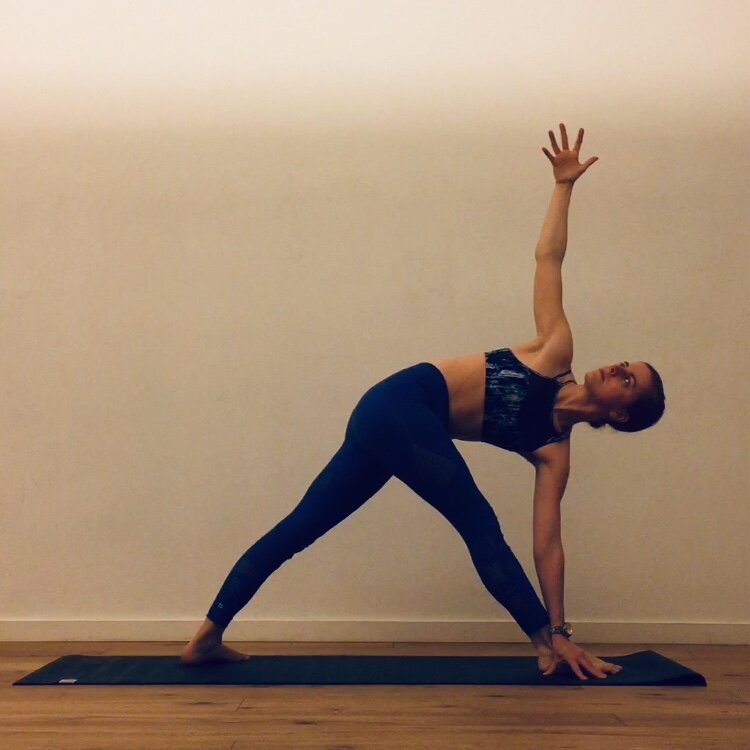Options for arm position in revolved triangle
Olivia Marley
As part of our focus on the warrior one family of postures we’ve been spending a bit of time in this pose, revolved triangle. For most bodies it’s a tough shape to make: it asks for a lot of mobility along the back and outside of your legs and hips; it can be pretty wobbly so hard to maintain your balance; plus it’s a deep twist so it can be hard to breathe in! We already looked at the position of your feet in this family of postures in my last blog post (having feet hip width apart rather than one behind each other is likely to make twisting into revolved triangle more accessible). In addition, to help students find more ease while holding this shape, we’ve been playing around a bit with the position of their arms.
PLACEMENT OF BOTTOM HAND
In the first picture here I have my fingertips on the floor on the outside of my front foot, which is the classical set up for revolved triangle. Even though LOTS of other postures don’t, twists naturally come fairly easily for my body and my torso turns enough that I can place my hand on the outside of my leg without having to reach for it too much. But for plenty of other people putting their hand on the outside of their front leg is a real stretch (no pun intended!). Their torso stops turning when their chest is still facing a little to the floor, so instead of just dropping their hand to the floor they have to reach past their leg to get their hand outside their foot - as seen in the second image here. That alignment made my chest feel kind of squashed and it was more difficult to breathe (as if it’s not hard enough to breathe deeply in a twist like this!).
So in class at the moment I’m bringing people into this pose with their bottom hand on the inside of their foot (as in the third image here), and then once everyone’s in the pose offering the option to put their hand on the outside of their foot. And I’d estimate that only about 10-20% of people are taking that option, so presumably the rest prefer having their hand on the inside!
HEIGHT OF BOTTOM HAND
I can get my hand on the floor in this pose, but for me using a block on its lowest height feels ideal. For lots of students trying to place their hand on the floor can be a real struggle. Trying to force your hand to the floor can meaning having to round (or in anatomical terms: flex) your spine a lot, which doesn’t set you up for a comfortable or easeful twist that you’re able to breathe in (see photo 2). In the third photo here I’ve placed my bottom hand on a brick, and you can perhaps see how that may enable students to keep their spines straighter and stay a bit broader across their chest as they turn.
TOP ARM
It’s really tempting in revolved triangle to throw your top hand back behind you as far as it will go, because it can feel like you’re twisting more. In fact what I often see happening when students do that it is their top shoulder shifts forward and their chest hasn’t actually turned any further (photo 2). So I’ve been cueing students to bring their top hand either directly over their top shoulder or a little forwards (where forwards in these images means towards the camera), and to imagine they’re pressing that palm into something solid like a wall. Then plenty of them have been able to shift their top shoulder a little further back (compare my top shoulder in image 2 to to it in image 3).
This approach is part of one of my wider aims for my students in 2020:
Encouraging students to test out slightly different positions within the poses, and to find what works for them
Letting go of the need to try and force themselves into a posture that looks a certain way, or of thinking that there’s only one way to do each yoga pose. Different bodies will look different doing the same postures!
Comment below with any questions, thoughts, or with your experience of revolved triangle or warrior 1 🙂






